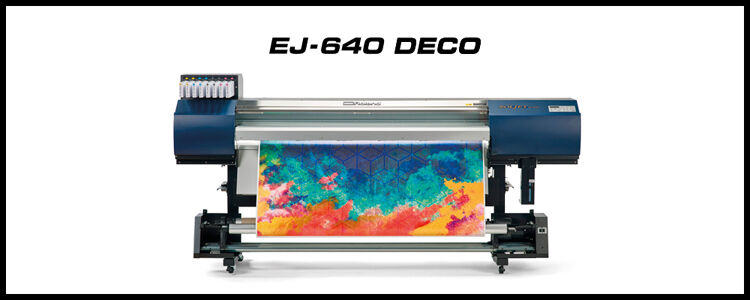Roland DG eyes interior design market with EJ-640 DECO

Print technology pioneer Roland DG has announced the launch of its new EJ-640 DECO, a printer that uses ecological water-based ink and has been designed to help users gain a competitive advantage in the interior design market.
Print technology pioneer Roland DG has announced the launch of its new EJ-640 DECO, a printer that uses ecological water-based ink and has been designed to help users gain a competitive advantage in the interior design market.
The EJ-640 DECO can be used to create various applications such as customised wallpaper, lampshades, blinds, posters, exhibition graphics and outdoor promotions.
The new device uses high-density water-based inks, which, according to Roland DG, are compatible with a wide range of media including coated, uncoated, PVC free and standard wallpaper from sustainable sources.
EJ-640 DECO inks deliver bold, light-fast and washable prints, while Roland DG also said the inks are also fast drying, which in turn allows the user to offer same-day print, finish and supply. In addition, Roland DG said users will benefit from up to 50% cost saving on inks compared to similar printer systems.
Speaking to FESPA.com about the new printer, Rob Goleniowski, head of sales at Roland DG UK, said while Roland DG already had a number of solutions available to the interior design industry, it was keen to develop a machine designed to meet specific needs in this creative sector.
“The printer is ideal for a range of business types, including both sign-makers and print service providers that currently provide interior décor with other ink technologies, and are seeing a demand for more ecological solutions,” Goleniowski said.
“It is also suitable for wallpaper manufacturers looking to provide short run, bespoke or proofing capabilities, as well as interior design companies looking to bring production in house.
“In a market that has seen a surge of interest in bespoke designs, thanks to lifestyle and DIY TV shows, and décor influencers on social media, all these businesses can offer short to long runs with virtually no setup costs, feeding the demand and adapting quickly to new trends.”
Focusing on the key features of the new EJ-640 DECO, Goleniowski picked out the environmental benefits of using water-based inks as a huge plus point for users.
“Water-based inks are among the cleanest and safest inks available and many are certified by international regulatory bodies,” Goleniowski said. “Print professionals have a competitive edge if they can cite these certifications as part of any proposal.”
Going further, Goleniowski said that the machine’s ability to work with a whole range of media also makes it an attractive proposition to companies creating products of all kinds.
“The EJ-DECO has excellent media compatibility, letting you use specialist, sustainably sourced media, and boost your environmental credentials,” Goleniowski said. “Also, with key media characteristics such as breathability and the possibility to cover imperfect wall surfaces, almost any wall can be decorated.
“And with low production costs, low electricity use and fast turnaround times, the return-on-investment prospects for this device are superb.”
Topics
Interested in joining our community?
Enquire today about joining your local FESPA Association or FESPA Direct
Recent news

The importance of ink for large format printers
Ink is crucial for large format inkjet printers, influencing substrate compatibility, productivity, and cost. Nessan Cleary discusses the three main types which include UV-curable ink, latex ink and eco-solvent ink. Each ink type has specific strengths and weaknesses, making printers choice dependent on budget and intended applications.

What are the benefits of Direct-To-Fabric printing?
Direct-to-fabric printing is gaining popularity for high-volume textile production, enabling on-demand, customized short runs. These printers offer ink flexibility, accommodating various fabric types like cotton and silk, though ink development focuses on faster turnaround by reducing pre- and post-processing. Compared to traditional methods, direct-to-fabric inkjet printing is a more sustainable option due to reduced water and chemical usage, and localized production.

What are the opportunities for large format providers regarding digital touch screens?
Digital touchscreens are becoming increasingly common, offering businesses opportunities to improve customer engagement and streamline operations. Nessan Cleary shares, while more expensive to implement than standard digital displays due to complex software and integration needs, touchscreens provide self-service options, multilingual support, and can reduce staffing costs in various settings like retail, transportation, and healthcare.
